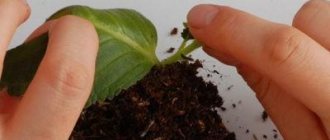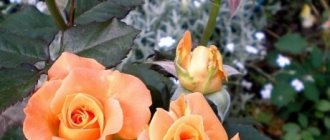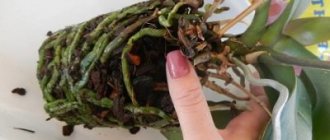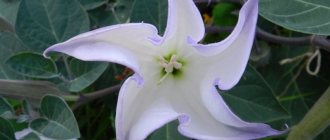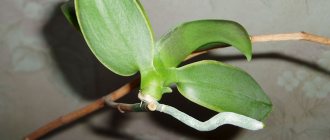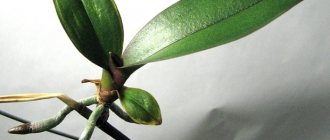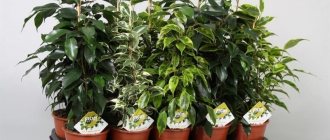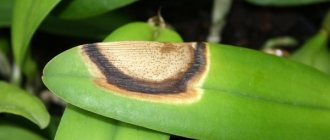What does it look like?
On average, the height of the plant reaches 15-20 cm, the size of the flowers, depending on the variety, can be from 4 cm to 7 cm. The number of petals depends on the age of the plant; on average, mini-orchids have 5-7 leaves, which are bright green in color. throughout the year . The number of flowers on a peduncle can reach fifteen, and it is advisable to use special support nets so that the plant does not break under their weight.
Attention : Mini orchids have a larger number of flowers on the peduncle than ordinary types. The shape of the flower is symmetrical, with identical petals. The smallest type of mini-orchids reaches a leaf span of 20 cm, and a flower diameter of 3-4 centimeters.
What problems might you encounter?
If the leaves of a mini-flower have lost their smoothness and become covered with wrinkles, this may indicate that the orchid lacks moisture. Try to water the orchid according to all the rules. If the leaves become smooth and elastic again, the problem lies precisely in improper watering.
Leaves may lose elasticity and firmness even when diseases of the root system begin. With insufficient watering, the roots dry out, and with abundant watering, they rot. The leaves do not receive the necessary nutrition, they begin to dry out, turn yellow, and become lethargic and lifeless. In this case, it is necessary to revive the indoor plant.
If a small orchid does not bloom, there may be several reasons:
- Lack of sunlight;
- Unsuitable room temperature;
- Too strong and frequent drafts;
- Dry air;
- Incorrectly selected fertilizer with a high nitrogen content.
Miniature species and varieties, their photos
Today, the most popular mini-brands of orchids are the flowers, the descriptions of which you will see below.
Cattleya
One of the most popular is Cattleya. This species is well suited for home cultivation. The most common variety of Catleya is Walker . The leaves of the crop rarely grow longer than 10 cm. The flowers reach 8-10 cm in diameter.
We recommend watching a video about the features of the mini-orchid “Cattleya”:
Ascocenda
Ascocenda blooms 3–6 times a year and, like its relatives, does not require careful care. Many new gardeners begin their floral journey with this plant.
We recommend watching a video about the features of the Ascocenda mini-orchid:
Dwarf oncidium
Oncidium is a very unpretentious type of orchid, which is also popular for home breeding . The peduncle can contain up to 4 relatively large flowers, the diameter of which is 6-8 cm. The flowers can be white, yellow, orange and lilac.
We recommend watching a video about the features of the mini-orchid “Dwarf Oncidium”:
Cymbidium
Another look, very attractive in appearance. The flower can please you with white, yellow, pink and cream colors. The peduncle is hanging, surrounded by narrow long leaves.
We recommend watching a video about the features of the Cymbidium mini-orchid:
Mini phalaenopsis
Dwarf Phalaenopsis orchids are especially popular among gardeners . This species has a very long flowering period. The height of the peduncle can be about 30 cm, which is equal to the length of the leaves.
Phalaenopsis Mini Mark, which belongs to the category of hybrid crops. The plant has an orange-brown flower color and bright green leaves. The length of the leaves can be from 10 to 15 cm. The peculiarity of this variety lies in the unusual color of the flowers themselves. The petals of the flower seem to be stained in places with yellow, orange and pink paint.
We recommend watching a video about the features of growing Mini-phalaenopsis:
How do dwarf orchids reproduce?
Orchid propagation is a serious process that gardeners approach with all responsibility. How do mini-flowers reproduce?
As a rule, the vegetative method is used. The small baby is carefully separated from the adult plant. The shoot is placed in a pre-prepared mini-greenhouse. A pre-moistened layer of sphagnum is laid out in the greenhouse.
On a note! The shoot necessary for propagation can be obtained no earlier than in a year.
Propagation of the flower should occur at a time when flowering is coming to an end. In this case, the plant will direct all internal resources to the reproduction process. Only healthy orchids, without signs of disease, are allowed to reproduce. The diseased plant should be completely cured, given time to recover, and only then should it be propagated.
Small orchids are an excellent solution for gardeners who do not have a large area for growing beautiful flowering plants. Significantly saving space, miniature orchids will nevertheless delight their owners with repeated flowering. If you know how to properly care for babies, orchids will be able to bring pleasure for a long time with their delightful luxurious flowers.
What kind of pots and soil are needed?
Important : For growing mini-orchids, special sphagnum moss or peat moss is used. Moreover, after the purchase, many gardeners advise dividing the plants into their own pots, which have oak bark in their soil composition.
Moss retains moisture much longer than a regular substrate, so you should not water the plant frequently, as this leads to rotting of its root system.
Plastic vessels are usually used as pots in which orchids are purchased . Their size is from 6-8 cm in diameter.
This container can be placed in a glass or plastic pot that matches the interior, thus hiding it. Some varieties of mini orchids are grown hanging because they have rich clusters of flowers. In this case, pots for orchids should be transparent, this will provide better access of light to the root system.
Choosing the right container and soil
Unlike ordinary orchids, dwarf flowers need special soil. Large plants grow well in crushed conifer bark, as well as in a special substrate with a large number of constituent components. For small orchids, special soil is selected. The composition of the soil can be as follows:
- Sphagnum moss;
- Crushed charcoal;
- Very fine pine bark.
In the presence of the last two components, the liquid does not linger in the substrate, which helps to avoid rotting of the root system.
The flower pot should be small and suitable in size for a small flower. You can make a container with your own hands using a small bowl with several holes in the bottom and on the walls.
Care instructions
Any indoor flower requires certain conditions for growth and flowering . The best conditions for a mini orchid are:
- room temperature without sudden changes;
- maintaining moist air;
- Avoid exposing the plant to direct sunlight;
- fertilize the flower according to the instructions
How to fertilize?
- The orchid needs to be fertilized no earlier than one and a half to two months after transplantation.
- You should not fertilize plants that have rot.
- You can fertilize the plant only after watering.
- In summer, the orchid needs to be fertilized 2 times a month, in winter - no more than once a month.
- Do not fertilize your orchid while it is blooming.
Types of fertilizers:
- Root . Used to stimulate plant growth. After watering, following the instructions on the package, you need to dilute the fertilizer in water and place it in the ground with the flower. After fertilizing, the flower should be moved to a warm room for several hours. At the same time, if the flower is located near a window or balcony, it should be moved to different points in the room so that direct light from the sun does not fall on the plant.
- Foliar . In this case, the orchid should not be watered, but sprayed. Also, following the instructions, you should dilute the fertilizer in water and apply it to the leaves of the plant using a spray bottle. And in this case, during fertilization, the leaves should not be exposed to direct sunlight. Avoid getting fertilizer on buds and flowers. It is necessary to fertilize the plant every 10-14 days during the period of active growth of mini-orchids, and no more than once a month during the dormant period. This period is characterized by the suspension of physiological processes. Visually, the plant in this state does not grow and does not show significant changes. During the dormant period, it is not recommended to fertilize the plant. For mini-orchids these are the periods of summer (hot months) and late autumn.
How to transplant?
You can use the general step-by-step instructions for replanting orchids, keeping in mind the following features of replanting miniature orchids:
If your miniature orchid grows on a “cushion” of moss, then you need to replant such an orchid once a year. The mini-orchid should be replanted in the spring during the period of active growth and until the peduncle is completely formed.
- To separate old soil or moss from the orchid's roots, place the orchid in a container of water for a few minutes. Let the water saturate the soil (moss) and separate the orchid roots from the soil one by one.
- If you decide to transplant an orchid into soil consisting of bark, then use soil consisting of fine pieces of bark.
The pot for a mini orchid should be a little tight . Thus, it ensures good breathability of the orchid soil. You can use the transparent pot in which the orchid grew, after washing it thoroughly.
We recommend watching a video about how to properly transplant a mini-orchid:
Reproduction nuances
In the case of mini-orchid propagation, a “child” is used, which is separated from the flower (vegetative propagation method). When a new shoot appears, it is carefully removed. Then it is immersed in a greenhouse, which has previously been laid out with wet sphagnum (peat moss).
Temperature and lighting
This type of orchid needs sunlight, but placing the flower in direct sunlight is dangerous: burns may appear on the leaves, the leaves quickly turn yellow and dry out. It is best to choose the eastern or western part of the house. If the flower is placed on the north or south side, you need to ensure that it is located in a dark place with diffused sunlight.
For dwarf phalaenopsis it is very important to choose the right temperature regime. The flower grows well in a temperature range of 17-29 degrees. If the temperature is incorrectly chosen, the orchid may get sick or even die.
You should also pay attention to differences in day and night temperatures. In summer the difference should be no more than 7-8 degrees, in winter – about 4 degrees.
Do not forget that sunlight is the source of life for dwarf plants, and even orchids that love shade cannot exist without adequate lighting. What happens to flowers that constantly remain in the shade:
- Flowering stops;
- The shedding of emerging buds and even flowers begins;
- Leaves change color and become less elastic;
- The plant stops growing.
All orchids are very afraid of drafts. The air flow can lead to hypothermia of the roots, leaves and peduncle. An orchid may stop blooming and stop growing. Gardeners should protect orchids from drafts by placing them in a place where there will be no drafts.
Pests and diseases
Mini orchids are not very susceptible to disease, but non-infectious diseases are quite common . Yellow leaves, wilted or curled leaf tips.
This can occur due to improper care, which includes the following points:
- Direct exposure to sunlight creates a burn on the leaves.
- Lack of light leads to withering of the plant.
- Excessively frequent watering will lead to rotting of the root system.
- Yellow leaves are also a sign that the plant is frozen.
- A room that is too warm can cause the orchid to wilt.
The main pests of mini-orchids:
- Scale insect - the insect looks like a hard oval aphid with a brown-black color. It can very quickly destroy a plant by multiplying on the leaves and trunk of the plant. The main danger is that males can fly and infect other plants in the room.
- Aphids are small harmful insects that have the color of the plant on which they live. “Indoor” or “house” aphids can be white, black or green in color. Insects live in small colonies. They feed on the plant sap, causing it to quickly wither.
The scale insect is the most dangerous pest among these representatives. The scale insect not only feeds on the sap of the plant, but also secretes mucus, which promotes the appearance of fungi and attracts other insects. This is an oval-shaped insect, approximately 4 mm in size. There are 2 types:
- bristly bug - a red oval body with a white coating;
- citrus bug - color varies from orange to black with white spots.
If a mini-orchid is severely damaged, the damaged parts of the plant should be removed and sprayed with fungicides. If the same orchid is damaged again, the same drug cannot be used. Because infectious fungal spores very quickly develop immunity against fungicidal drugs.
From our other materials you can learn about the best types and varieties of orchids. Read about the mysterious Bulbophyllum, variegated Zygopetalum, luxurious Multiflora, pearly Ludisia, frightening Dracula, curly Vanilla, exquisite Cambria, gentle Philadelphia, charming Sogo and extraordinary Brassia.
Varieties of mini orchids
It would be strange if the largest number of miniature orchids were not bred on the basis of the most popular variety of this flower. Unpretentious phalaenopsis have gained immense popularity among gardeners all over the world, and it is representatives of this genus of orchids that can be found on sale most often.
However, in reality, miniature hybrids can be found in the “lines” of many other orchid genera. In addition to phalaenopsis, the following are also grown at home:
- mini dendrobiums;
- mini cattleyas;
- mini-oncidiums;
- mini-paphiopedilums (lady's slipper);
- mini cymbidiums.
The main thing you need to pay attention to when choosing hybrids for growing in an apartment is not the size, but the genus. You will have to tinker with a miniature cymbidium no less than with a “full-scale” flower. In this case, a mini-phalaenopsis will not take much more time than a regular one.
The good news is that if you have mastered the basic techniques for growing specific varieties of orchids, then adapting to caring for their miniature copies will not be too difficult for you.
Popular mini-phalaenopsis: Sogo Vivien, Mini dog, Mini Mark.
- Which orchid to choose for a beginner - advantages and disadvantages of popular types
Plunge into the luxurious world of orchids and choose a new tenant for your home or winter garden!
Watering orchids on a moss “cushion”
These need to be watered more often than those growing in bark, but less water is needed.
The moisture capacity of moss is higher than that of bark: it absorbs 25 times more water than it weighs. This is achieved thanks to empty, unclosed cells that fill with liquid in a short time.
So, watering a mini-orchid growing in moss by immersion or spillage can result in the soil moisture being too high.
So it is recommended to spray the soil a couple of times a day. Well, or water from a spoon - from a table spoon or a tea spoon, depending on the size of the pot. This amount of water will disperse throughout the moss in a short time.
If the orchid is not watered for several days, its leaves become slightly wrinkled. Then the plant must be watered using any of the methods described above. If the cause of wrinkling was precisely lack of watering, the shape of the leaves will be restored.
But if it does not recover, it means that the roots of the plant have died. Then we urgently need to resuscitate it and build up a new root system.
Adviсe
Experienced flower growers give the following advice:
- If the leaves of the mini orchid begin to turn yellow with regular watering, reduce its frequency. If after this the plant does not feel better, replant it.
- If the leaves turn dark green and begin to wrinkle, the frequency of watering must be increased.
- If buds and flowers fall off, make sure that the air temperature does not exceed 30 ° C, and the air humidity does not fall below 50-60%. Try to create optimal conditions for mini phalaenopsis.
- If the leaves are rotting, you are most likely not watering the plant correctly or not wiping off the leaves with a shower. It is important for the orchid that after water treatments the leaves become dry as quickly as possible. Therefore, they need to be wiped with a dry cloth. Pay special attention to the space between the shoots.
While the mini orchid is rarely found on the shelves of domestic flower shops. But it amazes with its miniature and sophistication: it is impossible to pass by it. Plant this miracle on your windowsill, and it will delight you with long-lasting flowering from spring to late autumn.



